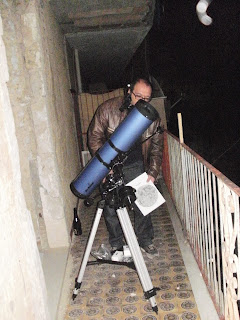Tonight I watched the sky from my house,with my telescope.
Fred and I, we observed the Moon and Jupiter, and I must say that you can see very well with my telescope.
I observe a skywatcher 130/900.
After seeing Jupiter, we observed the Moon very well
We observed:
Plato crater and the surrounding area,located in the northwestern part of the lunar disk visible to us.
Plato is at the end of the Alpes.
Plato is a lunar impact crater on the Moon, it is located on the north-east of Mare Imbrium, western end of the Montes Alpes, mountain range.
The age of Plato is about 3.84 billion years.The rim is irregular with jagged peaks of 2 km above the first floor of the cast shadows across the crater floor.
Plato the circle is round , but the Earth appears oval due to foreshortening.
Let the Mare Ibrium.
It is a vast lunar sea, with a diameter of 1123 km.
Mare is a latin term used to desribe different morfological configurations on the surface of the Moon.
The term was chosen because of the dark color that distinguishes these regions from the surronding territories.
This is indeed the basalt plain, originated from ancien eruptions of incandescent material impact with particularly massive asteroids.
The Mare Frigoris, rarely told Sea of Cold( ocean of Storm), is a lunar sea located on the hemisphere of the satellite always faces the Earth, just north of Mare Ibrium (the sea of rains) and northeast of the Mare Serenitatis (sea of serenity), is a peripherial region of Oceanus Procellarium.
Just south the Mare Frigoris, is clear the crater Plato.
Here is a map of the lunar sea:
Then we saw the Vallis Alpina, a thin crack of the lunar surface, distinticly visible at top center.
The crater looking down of the far right is Cassini,inside has two crater, obviously more recent.
The large crater visible on the left of the Alpes is Plato.
We saw a part of our satellit whic is midway between the Alps, the Caucasus, the Apennines.The two craters at the center are Autolycus, Aristillus left and right. The crater colse to the Alps, the far right and a crater on the inside, is Cassini.
My first photos taken with a digital camera:







